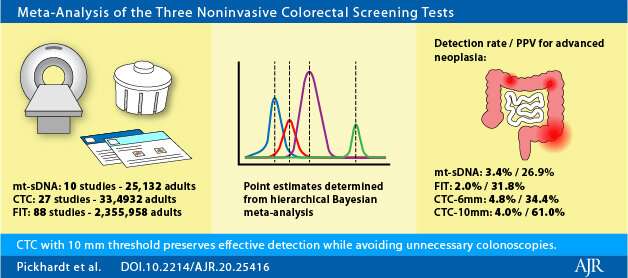#CT colonography most effective noninvasive colorectal cancer screening test

“#CT colonography most effective noninvasive colorectal cancer screening test”

According to an open-access article in ARRS’ American Journal of Roentgenology (AJR), compared with multi-target stool-DNA (mt-sDNA) and fecal immunochemical test (FIT), CT colonography (CTC) with 10 mm threshold most effectively targets advanced neoplasia (AN)—preserving detection while decreasing unnecessary colonoscopies.
“CTC performed with a polyp size threshold for colonoscopy referral set at 10 mm represents the most effective and efficient non-invasive screening test for colorectal cancer (CRC) prevention and detection,” clarified first author Perry J. Pickhardt from the department of radiology at the University of Wisconsin School of Medicine & Public Health.
Because the relative performance characteristics of available noninvasive tests had not yet been adequately compared, Pickhardt’s team systematically searched PubMed and Google Scholar, including 10 mt-sDNA, 27 CTC, and 88 FIT published screening studies involving 25,132, 33,4932, and 2,355,958 asymptomatic adults, respectively. To determine test-positivity rates (TPR) leading to optical colonoscopy (OC), as well as positive predictive value (PPV) and detection rate (DR) for both AN and CRC, meta-analysis with hierarchical Bayesian modeling was conducted, in accordance with Cochrane Collaboration and PRISMA guidelines.
Pickhardt and colleagues’ results showed that CRC prevention via screen detection of AN was highest with CTC, followed by mt- sDNA, and lowest with FIT due to the differing TPR and PPV, although overlap existed in the 95% CIs when accounting for uncertainty. Compared with mt-sDNA and CTC6, FIT and CTC10 strategies yielded substantially lower colonoscopy resource utilization, while mt-sDNA performance appeared to be similar to FIT at low positivity thresholds.
Acknowledging that each CRC screening option has relative advantages and disadvantages that should be carefully considered and tailored to the individual, “in the end,” the authors of this AJR article concluded, “the ‘best’ test may be the one that the patient is willing to undergo.”
An electronic supplement to this article is available here: https://www.ajronline.org/doi/10.2214/AJR.20.25416
Study finds non-invasive colon cancer screening may be promising for African-Americans
Perry J. Pickhardt et al, PPV and Detection Rate of mt-sDNA, FIT, and CT Colonography for Advanced Neoplasia: A Hierarchical Bayesian Meta-Analysis of the Noninvasive Colorectal Screening Tests, American Journal of Roentgenology (2021). DOI: 10.2214/AJR.20.25416
Citation:
CT colonography most effective noninvasive colorectal cancer screening test (2021, March 12)
retrieved 13 March 2021
from https://medicalxpress.com/news/2021-03-ct-colonography-effective-noninvasive-colorectal.html
This document is subject to copyright. Apart from any fair dealing for the purpose of private study or research, no
part may be reproduced without the written permission. The content is provided for information purposes only.
If you liked the article, do not forget to share it with your friends. Follow us on Google News too, click on the star and choose us from your favorites.
For forums sites go to Forum.BuradaBiliyorum.Com
If you want to read more Like this articles, you can visit our Science category.


